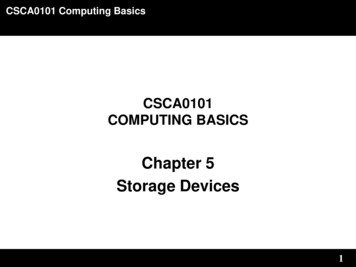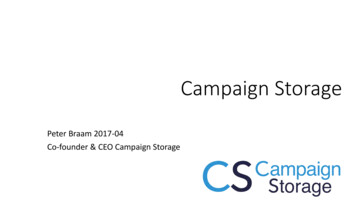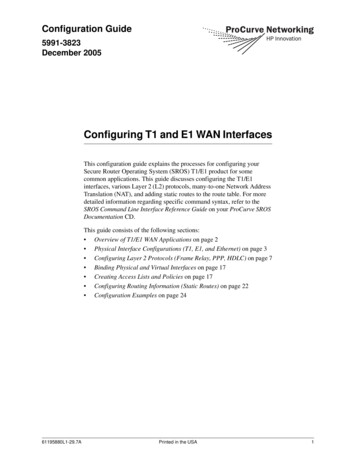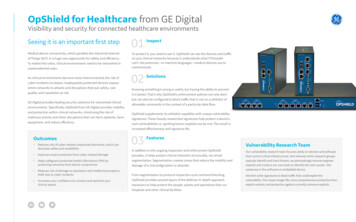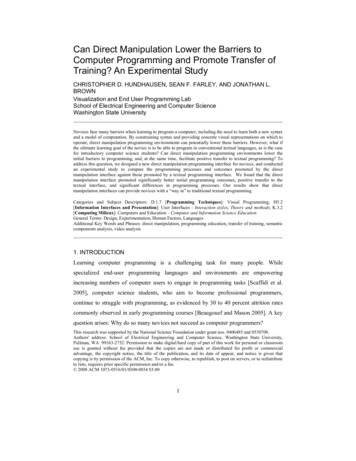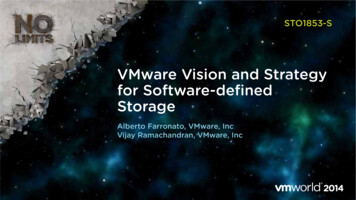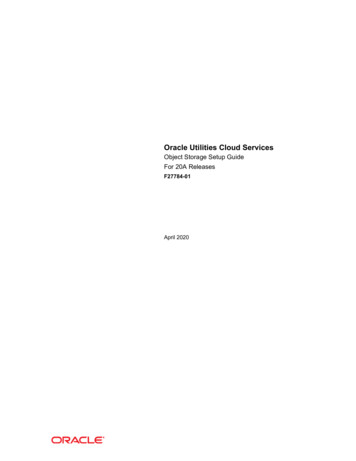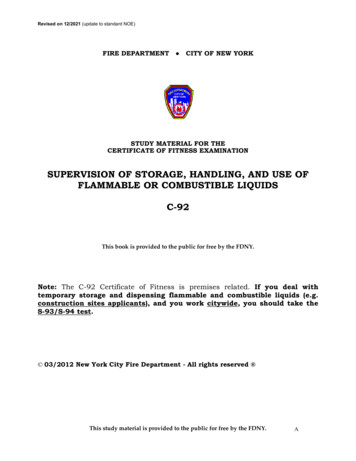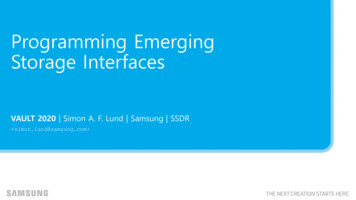
Transcription
Programming EmergingStorage InterfacesVAULT 2020 Simon A. F. Lund Samsung SSDR simon.lund@samsung.com
Programming Emerging Storage Interfaces: Why?Command: 64byte Submission Queue Entry (sqe) The device media changed The device interface changed Command Response Protocol QueuesResponse: (at least) 16byte Completion Queue Entry (cqe)- Submission Entries- Completions Entries1
Programming Emerging Storage Interfaces: Why? New devices doing old things faster The software storage-stack becomes the bottleneck Requires: efficiency2
Programming Emerging Storage Interfaces: Why? New devices doing old things faster The software storage-stack becomes the bottleneck Requires: efficiency New devices doing old things in a new way Responsibilities trickle up the stack Host-awareness, the higher up, the higher the benefits Device OS Kernel Application Requires: control, as in, commands other than read/write3
Programming Emerging Storage Interfaces: Why? New devices doing old things faster The software storage-stack becomes the bottleneck Requires: efficiency New devices doing old things in a new way Responsibilities trickle up the stack Host-awareness, the higher up, the higher the benefits Device OS Kernel Application Requires: control, as in, commands other than read/write New devices doing new things! New storage semantics such as Key-Value New hybrid semantics introducing compute on and near storage Requires: flexibility / adaptability, as in, ability to add new commands4
Programming Emerging Storage Interfaces: Why? New devices doing old things faster The software storage-stack becomes the bottleneck Requires: efficiency New devices doing old things in a new way Responsibilities trickle up the stack Host-awareness, the higher up, the higher the benefits Device OS Kernel Application Requires: control, as in, commands other than read/write New devices doing new things! New storage semantics such as Key-Value New hybrid semantics introducing compute on and near storage Requires: flexibility / adaptability, as in, ability to add new commands Increased requirements on the host software stack5
Programming Emerging Storage Interfaces: Using io uring The newest Linux IO interface: io uring A user space kernel communication channel A transport mechanism for commands6
Programming Emerging Storage Interfaces: Using io uring The newest Linux IO interface: io uringCommand: 64byte Submission Queue Entry (sqe) A user space kernel communication channel A transport mechanism for commands Queue Based (ring mem. kernel user space) Submission queue- populated by user space, consumed by Kernel Completion queue- populated by kernel, in-response- consumed by user spaceResponse: 16byte Completion Queue Entry (cqe)7
Programming Emerging Storage Interfaces: Using io uring The newest Linux IO interface: io uringCommand: 64byte Submission Queue Entry (sqe) A user space kernel communication channel A transport mechanism for commands Queue Based (ring mem. kernel user space) Submission queue- populated by user space, consumed by Kernel Completion queue- populated by kernel, in-response- consumed by user space A syscall, io uring enter, for sub. compl.Response: 16byte Completion Queue Entry (cqe) A second for queue setup (io uring setup) Resource registration (io uring register)8
Programming Emerging Storage Interfaces: Using io uring It is efficient* on a single core one can get 1.7M IOPS (polling) 1.2M IOPS (interrupt driven) The Linux aio interface was at 608K IOPS (interrupt driven) It is quite flexible Works with UNIX file abstraction- Not just when it encapsulates block devices Growing command-set (opcodes) It is adaptable- Add a new opcode implement handling of it in the Kernel*Efficient IO with io uring, https://kernel.dk/io uring.pdfKernel Recipes 2019 - Faster IO through io uring, https://www.youtube.com/watch?v -5T4Cjw46ys9
Programming Emerging Storage Interfaces: Using io uring Advanced Features Register files (RF) Fixed buffers (FB) Polling IO (IOP) SQ polling by Kernel Thread (SQT)10
Programming Emerging Storage Interfaces: Using io uring Advanced Features4K Random Read(Interrupt) Register files (RF)aio Fixed buffers (FB) Polling IO (IOP)io uring SQ polling by Kernel Thread (SQT) Efficiency revisited Null Block instance w/o block-layerio uring RF FB4K Random Read(SQT Polling)Latency(nsec)IOPSQD1IOPSQD161200 741 K749 K926 922 K927 K807 1.05 M1.02 MLatency(nsec)IOPSQD1IOPSQD16io uring SQT RF644 1.25 M1.7 Mio uring SQT RF FB567 1.37 M2.0 M11
Programming Emerging Storage Interfaces: Using io uring Advanced Features4K Random Read(Interrupt) Register files (RF)aio Fixed buffers (FB) Polling IO (IOP)io uring SQ polling by Kernel Thread (SQT) Efficiency revisited Null Block instance w/o block-layer Efficiency vs Ease of Useio uring RF FB4K Random Read(SQT Polling)Latency(nsec)IOPSQD11200 741 K749 K926 922 K927 K807 1.05 M1.02 MLatency(nsec)IOPSQD1644 1.25 M Opcode restrictions when using FB io uring SQT RF Do not use IOP SQTio uring SQT RF FB567 1.37 M Know that register files is required for SQT Use buffer and file registration indexes instead of *iov and handles12IOPSQD16IOPSQD161.7 M2.0 M
Programming Emerging Storage Interfaces: Using io uring Advanced Features4K Random Read(Interrupt) Register files (RF)aio Fixed buffers (FB) Polling IO (IOP)io uring SQ polling by Kernel Thread (SQT) Efficiency revisited Null Block instance w/o block-layer Efficiency vs Ease of Useio uring RF FB4K Random Read(SQT Polling)Latency(nsec)IOPSQD11200 741 K749 K926 922 K927 K807 1.05 M1.02 MLatency(nsec)IOPSQD1644 1.25 M Opcode restrictions when using FB io uring SQT RF Do not use IOP SQTio uring SQT RF FB567 1.37 M Know that register files is required for SQT Use buffer and file registration indexes instead of *iov and handles rtfm, man pages, pdf, mailing-lists, github, and talks document it well liburing makes it, if not easy, then easier13IOPSQD16IOPSQD161.7 M2.0 M
Programming Emerging Storage Interfaces: Using Linux IOCTLs The oldest? Linux IO interface: IOCTL A kernel user space communication channel The interface is Not efficient Adaptable but not flexible- Never break user space! Control oriented14
Programming Emerging Storage Interfaces: Using Linux IOCTLs The oldest? Linux IO interface: IOCTLCommand: 80byte Submission Completion A kernel user space communication channel The interface is Not efficient Adaptable but not flexible- Never break user space! Control oriented However, the NVMe driver IOCTLs are A transport mechanism for commands Very flexible – pass commands without changing the Kernel Rich control, but not full control, of the NVMe command / sqe Can even be used for non-admin IO, however, not efficiently15
Programming Emerging Storage Interfaces: Assisted by Linux sysfs The convenient Linux IO interface: sysfs A kernel user space communication channel File system semantics to retrieve system, device, and driver information- Great for retrieving device properties16
Programming Emerging Storage Interfaces: On Linux Everything you need encapsulated in the file abstraction io uring / liburing for efficiency sysfs for convenient device and driver information NVMe IOCTLs for control and flexibility17
Programming Emerging Storage Interfaces using Intel SPDK The Storage Platform Development Kit Tools and libraries for high performance, scalable, user-mode storageapplications It is efficient* 10M IOPS from one thread Thanks to a user space, polled-mode,asynchronous, lockless NVMe driver zero-copy command payloads It is flexible Storage stack as an API It is extremely adaptable- Full control over SQE construction*10.39M Storage I/O Per Second From One Thread, https://spdk.io/news/2019/05/06/nvme/18
Programming Emerging Storage Interfaces using Intel SPDK The Storage Platform Development Kit Tools and libraries for high performance, scalable, user-mode storageapplications It is efficient* revisited 4K Random Read at QD1 On physical locally attached NVMe deviceQD1: io uring vs SPDKio uring SQT RFIOPSBWSPDK150 K 587 MB/s117 K 479 MB/s*10.39M Storage I/O Per Second From One Thread, https://spdk.io/news/2019/05/06/nvme/19
Programming Emerging Storage Interfaces using Intel SPDK The Storage Platform Development Kit Tools and libraries for high performance, scalable, user-mode storageapplications It is efficient* 10M IOPS from one thread Thanks to a user space, polled-mode,asynchronous, lockless NVMe driver zero-copy command payloads It is flexible Storage stack as an API It is extremely adaptable- Full control over SQE construction*10.39M Storage I/O Per Second From One Thread, https://spdk.io/news/2019/05/06/nvme/20
Programming Emerging Storage Interfaces using xNVMe21
Programming Emerging Storage Interfaces using xNVMe A unified API primarily for NVMe devices22
Programming Emerging Storage Interfaces using xNVMe A unified API primarily for NVMe devices A cross-platform transport mechanism for NVMe commands A user space device communication channel23
Programming Emerging Storage Interfaces using xNVMe A unified API primarily for NVMe devices A cross-platform transport mechanism for NVMe commands A user space device communication channel Focus on being easy to use Reaping the benefits of the lower layers Without sacrificing efficiency! High performance and high productivity24
Programming Emerging Storage Interfaces using xNVMe A unified API primarily for NVMe devices A cross-platform transport mechanism for NVMe commands A user space device communication channel Focus on being easy to use Reaping the benefits of the lower layers Without sacrificing efficiency! High performance and high productivity Tools and utilites Including tools to build tools25
Programming Emerging Storage Interfaces using the xNVMe API xNVMe Base API Lowest level interface Device Handles Identifiers Enumeration Geometry Memory Management Command payloads Virtual memory Command Interface Synchronous Asynchronous- Requests and callbacks26
Programming Emerging Storage Interfaces using the xNVMe API xNVMe Base API Lowest level interface Device Handles Identifiers Enumeration GeometryTwo devices in the systemOne is attached to the user space NVMe driver (SPDK)The other is attached to the Linux Kernel NVMe Driver27
Programming Emerging Storage Interfaces using the xNVMe API xNVMe Base API Lowest level interface Device Handles Identifiers Enumeration Geometry Memory Management Command payloads Virtual memory Command Interface Synchronous Asynchronous- Context and callback28
Programming Emerging Storage Interfaces using the xNVMe API xNVMe Base API Lowest level interface Device Handles Identifiers Enumeration Geometry Memory Management Command payloads Virtual memory Command Interface Synchronous Asynchronous- Context and callback29
Programming Emerging Storage Interfaces using the xNVMe API xNVMe Base API Lowest level interface Device Handles Identifiers Enumeration Geometry Memory ManagementWhen possible: the buffer-allocators will allocate physical / DMAtransferable memory to achieve zero-copy payloads Command payloads Virtual memory Command Interface Synchronous Asynchronous- Context and callback30
Programming Emerging Storage Interfaces using the xNVMe API xNVMe Base API Lowest level interface Device Handles Identifiers Enumeration Geometry Memory Management Command payloads Virtual memory Command InterfaceWhen possible: the buffer-allocators will allocate physical / DMAtransferable memory to achieve zero-copy payloadsThe virtual memory allocators will by default use libc butare mappable to other allocators such as TCMalloc Synchronous Asynchronous- Context and callback31
Programming Emerging Storage Interfaces using the xNVMe API xNVMe Base API Lowest level interfaceCommand PassthroughThe user constructs the command Device Handles Identifiers Enumeration Geometry Memory Management Command payloads Virtual memory Command Interface Synchronous Asynchronous- Context and callback32
Programming Emerging Storage Interfaces using the xNVMe API xNVMe Base API Lowest level interfaceCommand PassthroughThe user constructs the command Device Handles Identifiers Enumeration Geometry Memory Management Command payloads Virtual memory Command Interface Synchronous Asynchronous- Context and callbackCommand EncapsulationThe library constructs the command33
Programming Emerging Storage Interfaces using the xNVMe API xNVMe Base API Lowest level interface Device Handles Identifiers Enumeration Geometry Memory Management Command payloads Virtual memory Command InterfaceSynchronous Command ExecutionSet command-option XNVME CMD SYNCCheck err for submission statusCheck req for completion status Synchronous Asynchronous- Context and callback34
Programming Emerging Storage Interfaces using the xNVMe API xNVMe Base API Lowest level interface Device Handles Identifiers Enumeration Geometry Memory Management Command payloads Virtual memory Command InterfaceAsynchronous Command ExecutionSet command-option XNVME CMD ASYNCCheck err for submission statusWhat about completions? Synchronous Asynchronous- Context and callback35
Programming Emerging Storage Interfaces using the xNVMe API xNVMe Base API Lowest level interface DeviceAsynchronous ContextOpaque structure backed by an encapsulation of anio uring sq/cq ring or an SPDK IO queue-pair. Handles Identifiers Enumeration Geometry Memory Management Command payloads Virtual memory Command Interface Synchronous AsynchronousHelper functions to retrieve maximum queue-depth andthe current number of commands in-flight / outstanding- Context and callback36
Programming Emerging Storage Interfaces using the xNVMe API xNVMe Base API Lowest level interfaceCallback function; called upon command completion Device Handles Identifiers Enumeration Geometry Memory Management Command payloads Virtual memory Command Interface Synchronous AsynchronousWait, blocking, until there are no more commandsoutstanding on the given asynchronous contextReap / process, at most max, completions,non-blocking- Context and callback37
Programming Emerging Storage Interfaces using the xNVMe API xNVMe Base API Lowest level interfaceCommand completion result; used by the synchronousas well as the asynchronous command modes Device Handles Identifiers Enumeration Geometry Memory Management Command payloads Virtual memory Command Interface Synchronous AsynchronousAsynchronous fields: context, callback, and callback-argument- Context and callback38
Programming Emerging Storage Interfaces using the xNVMe API xNVMe Asynchronous API Example39User-defined callback argument and callback function
Programming Emerging Storage Interfaces using the xNVMe API xNVMe Asynchronous API ExampleUser-defined callback argument and callback functionAsynchronous context and request-pool initialization40
Programming Emerging Storage Interfaces using the xNVMe API xNVMe Asynchronous API ExampleUser-defined callback argument and callback functionWriting a payload to deviceAsynchronous context and request-pool initialization41
Programming Emerging Storage Interfaces: What does it cost?*NOTE: System hardware, Linux Kernel, Software, NVMe Device Specs. and Null Block Device configuration in the last slide42
Programming Emerging Storage Interfaces: What does it cost? It is free, as in, APACHE 2.0*NOTE: System hardware, Linux Kernel, Software, NVMe Device Specs. and Null Block Device configuration in the last slide43
Programming Emerging Storage Interfaces: What does it cost? It is free, as in, APACHE 2.0 Evaluating potential efficiency* cost of using xNVMe Cost in terms of nanoseconds per command aka layer-overhead Benchmark using fio 4K Random Read at QD1 Compare the regular (REGLR) interface to xNVMe Using a physical locally attached NVMe device Using a Linux Null Block instance without the block-layer*NOTE: System hardware, Linux Kernel, Software, NVMe Device Specs. and Null Block Device configuration in the last slide44
Programming Emerging Storage Interfaces: What does it cost? It is free, as in, APACHE 2.0 Evaluating potential efficiency* cost of using xNVMe Cost in terms of nanoseconds per command aka layer-overhead Benchmark using fio 4K Random Read at QD1 Compare the regular (REGLR) interface to xNVMe Using a physical locally attached NVMe deviceComparingtoLatency (nsec)REGLR/io uring SQT RF8336xNVMe/io uring SQT RF8373 30nsecOverhead 36*NOTE: System hardware, Linux Kernel, Software, NVMe Device Specs. and Null Block Device configuration in the last slide45
Programming Emerging Storage Interfaces: What does it cost? It is free, as in, APACHE 2.0 Evaluating potential efficiency* cost of using xNVMe Cost in terms of nanoseconds per command aka layer-overhead Benchmark using fio 4K Random Read at QD1 Compare the regular (REGLR) interface to xNVMe Using a physical locally attached NVMe deviceComparingLatency (nsec)ComparingREGLR/io uring SQT RF8336REGLR/SPDK6471xNVMe/io uring SQT RF8373xNVMe/SPDK6510 30nsectoOverhead 36toLatency (nsec)Overhead 39*NOTE: System hardware, Linux Kernel, Software, NVMe Device Specs. and Null Block Device configuration in the last slide46
Programming Emerging Storage Interfaces: What does it cost? It is free, as in, APACHE 2.0 Evaluating potential efficiency* cost of using xNVMe Cost in terms of nanoseconds per command aka layer-overhead Benchmark using fio 4K Random Read at QD1 Compare the regular (REGLR) interface to xNVMe Using a physical locally attached NVMe deviceComparingLatency (nsec)ComparingREGLR/io uring SQT RF8336REGLR/SPDK6471xNVMe/io uring SQT RF8373xNVMe/SPDK6510 30nsectoOverhead 36toLatency (nsec)Overhead 39 Overhead about 36-39 nsec*NOTE: System hardware, Linux Kernel, Software, NVMe Device Specs. and Null Block Device configuration in the last slide47
Programming Emerging Storage Interfaces: What does it cost? It is free, as in, APACHE 2.0 Evaluating potential efficiency* cost of using xNVMe Cost in terms of nanoseconds per command aka layer-overhead Benchmark using fio 4K Random Read at QD1 Compare the regular (REGLR) interface to xNVMe Using a physical locally attached NVMe device 36-39 nsec Using a Linux Null Block instance without the block-layer*NOTE: System hardware, Linux Kernel, Software, NVMe Device Specs. and Null Block Device configuration in the last slide48
Programming Emerging Storage Interfaces: What does it cost? It is free, as in, APACHE 2.0 Evaluating potential efficiency* cost of using xNVMe Cost in terms of nanoseconds per command aka layer-overhead Benchmark using fio 4K Random Read at QD1 Compare the regular (REGLR) interface to xNVMe Using a physical locally attached NVMe device 36-39 nsec Using a Linux Null Block instance without the block-layerComparingtoLatency (nsec)REGLR/io uring SQT RF644xNVMe/io uring SQT RF730Overhead 86 Overhead about 86 nsec*NOTE: System hardware, Linux Kernel, Software, NVMe Device Specs. and Null Block Device configuration in the last slide49
Programming Emerging Storage Interfaces: What does it cost? It is free, as in, APACHE 2.0 Evaluating potential efficiency* cost of using xNVMe Cost in terms of nanoseconds per command aka layer-overhead Benchmark using fio 4K Random Read at QD1 Compare the regular (REGLR) interface to xNVMe Using a physical locally attached NVMe device 36-39 nsec Using a Linux Null Block instance without the block-layer 86 nsec Where is time spent? Function wrapping and pointer indirection Popping pushing requests from pool Callback invocation Pseudo io vec is filled and consumes space (io uring) Suboptimal request-struct layout*NOTE: System hardware, Linux Kernel, Software, NVMe Device Specs. and Null Block Device configuration in the last slide50
Programming Emerging Storage Interfaces: What does it cost? It is free, as in, APACHE 2.0 Evaluating potential efficiency* cost of using xNVMe Cost in terms of nanoseconds per command aka layer-overhead Benchmark using fio 4K Random Read at QD1 Compare the regular (REGLR) interface to xNVMe Using a physical locally attached NVMe device 36-39 nsec Using a Linux Null Block instance without the block-layer 86 nsec Where is time spent?Things an application it likely to requirewhen doing more than synthetically Function wrapping and pointer indirectionre-submitting upon completion Popping pushing requests from pool Callback invocation Pseudo io vec is filled and consumes space (io uring) Suboptimal request-struct layout*NOTE: System hardware, Linux Kernel, Software, NVMe Device Specs. and Null Block Device configuration in the last slide51
Programming Emerging Storage Interfaces: What does it cost? It is free, as in, APACHE 2.0 Evaluating potential efficiency* cost of using xNVMe Cost in terms of nanoseconds per command aka layer-overhead Benchmark using fio 4K Random Read at QD1 Compare the regular (REGLR) interface to xNVMe Using a physical locally attached NVMe device 36-39 nsec Using a Linux Null Block instance without the block-layer 86 nsec Where is time spent?Things an application it likely to requirewhen doing more than synthetically Function wrapping and pointer indirectionre-submitting upon completion Popping pushing requests from pool Callback invocationThings that need fixing Pseudo io vec is filled and consumes space (io uring) Suboptimal request-struct layout*NOTE: System hardware, Linux Kernel, Software, NVMe Device Specs. and Null Block Device configuration in the last slide52
Programming Emerging Storage Interfaces: What does it cost? It is free, as in, APACHE 2.0 Current cost, about 40 90 nanoseconds per command About the same cost as a DRAM load Cost less than not enabling IORING REGISTER BUFFERS ( 100nsec) Cost less than going through a PCIe switch ( 150nsec) Cost a fraction of going through the block layer ( 1850nsec) Cost a lot less than a read from todays fast media ( 8000nsec)53
Programming Emerging Storage Interfaces: What does it cost? It is free, as in, APACHE 2.0 Current cost, about 40 90 nanoseconds per command About the same cost as a DRAM load Cost less than not enabling IORING REGISTER BUFFERS ( 100nsec) Cost less than going through a PCIe switch ( 150nsec) Cost a fraction of going through the block layer ( 1850nsec) Cost a lot less than a read from todays fast media ( 8000nsec) Cost will go down!54
Programming Emerging Storage Interfaces: What does it cost? It is free, as in, APACHE 2.0 Current cost, about 40 90 nanoseconds per command About the same cost as a DRAM load Cost less than not enabling IORING REGISTER BUFFERS ( 100nsec) Cost less than going through a PCIe switch ( 150nsec) Cost a fraction of going through the block layer ( 1850nsec) Cost a lot less than a read from todays fast media ( 8000nsec) Cost will go down!Re-target your application without changesIOPSMB/s What do you get? An even easier API./your app pci:0000:01.00?nsid 1150 K613./your app /dev/nvme0n1116 K456- High-level abstractions when you need them- Peel of the layers and get low-level control when you do not Your applications, tools, and libraries will run on Linux, FreeBSD, and SPDK55
Programming Emerging Storage Interfaces: What does it cost? It is free, as in, APACHE 2.0 Current cost, about 40 90 nanoseconds per command Cost will go down! What do you get? An even easier APIRe-target your application without changesIOPSMB/s./your app pci:0000:01.00?nsid 1150 K613./your app /dev/nvme0n1116 K456- High-level abstractions when you need them- Peel of the layers and get low-level control when you do not Your applications, tools, and libraries will run on Linux, FreeBSD, and SPDK There is more!56
Programming Emerging Storage Interfaces: What does it cost? It is free, as in, APACHE 2.0 Current cost, about 40 90 nanoseconds per command Cost will go down! What do you get? An even easier APIRe-target your application without changesIOPSMB/s./your app pci:0000:01.00?nsid 1150 K613./your app /dev/nvme0n1116 K456- High-level abstractions when you need them- Peel of the layers and get low-level control when you do not Your applications, tools, and libraries will run on Linux, FreeBSD, and SPDK There is more! On top of the Base API: Command-set APIs e.g. Zoned Namespaces NVMe Meta File System – browse logs as files in binary and YAML Command-line tool builders (library and bash-completion generator)57
Programming Emerging Storage Interfaces: What does it cost? It is free, as in, APACHE 2.0 Current cost, about 40 90 nanoseconds per command Cost will go down! What do you get? An even easier APIRe-target your application without changesIOPSMB/s./your app pci:0000:01.00?nsid 1150 K613./your app /dev/nvme0n1116 K456- High-level abstractions when you need them- Peel of the layers and get low-level control when you do not Your applications, tools, and libraries will run on Linux, FreeBSD, and SPDK There is more! On top of the Base API: Command-set APIs e.g. Zoned Namespaces NVMe Meta File System – browse logs as files in binary and YAML Command-line tool builders (library and bash-completion generator) First release: https://xnvme.io Q1 202058
Programming Emerging Storage Interfaces: test rig Slides, logs and numbers will be made available on: https://xnvme.io System Spec Supermicro X11SSH-F Intel Xeon E3-1240 v6 @ 3.7Ghz 2x 16GB DDR4 2667 Mhz Software Debian Linux 5.4.13-1 / fio 3.17 / liburing Feb. 14. 2020 xNVMe 0.0.14 / SPDK v19.10.x / fio 3.3 (SPDK plugin) NVMe Device Specs.LatencyIOPSBWRandom Read8 usec190 K900 MB/secRandom Write30 usec35 K150 MB/sec Null Block Device Config (bio-based)queue mode 0 irqmode 0 nr devices 1 completion nsec 10 home node 0 gb 100 bs 512 submit queues 1hw queue depth 64 use per node hctx 0 no sched 0 blocking 0 shared tags 0 zoned 0 zone size 256 zone nr conv 0 Null Block Device Config (mq)queue mode 1 irqmode 0 nr devices 1 completion nsec 10 home node 0 gb 100 bs 512 submit queues 1hw queue depth 64 use per node hctx 0 no sched 0 blocking 0 shared tags 0 zoned 0 zone size 256 zone nr conv 060
Programming Emerging Storage Interfaces: Using io_uring The newest Linux IO interface: io_uring A user space kernel communication channel A transport mechanism for commands Queue Based (ring mem. kernel user space) Submission queue - populated by user space, consumed by Ke
